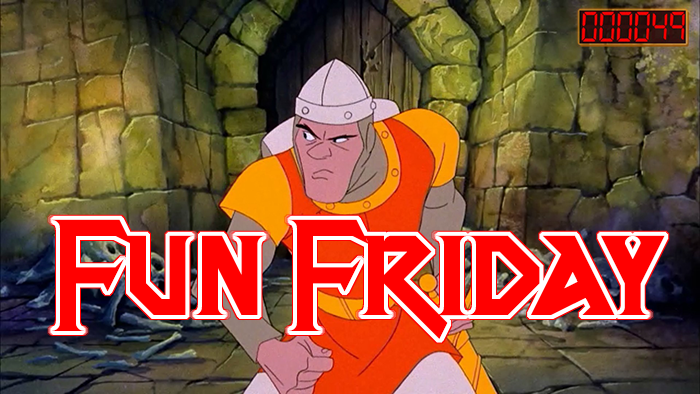“Lead on, adventurer. Your quest awaits.”
You’ll recognize those famous words if you’re an arcade game geek from way back. They stoked the fires of my rambunctious, 13-year-old heart and stirred me to some of my greatest adventures. The year was 1983 and an arcade game called Dragon’s Lair was a total gamechanger in what arcade games could be. I’m going to tell you all about Dragon’s Lair, but first…
…I Gotta Rip on Stuart Sweet
Stuart Sweet thought he was so cool with his blog about the History of Zaxxon. Well, I’m here to tell you that I don’t even think he ever played that game. His post didn’t mention Zaxxon himself, the gigantic boss robot the game is named after. Defeating that metallic beast was next to impossible because of how hard it was to hit its one and only weak spot. Stuart failed to mention this. He also said nothing of the near-perfect Zaxxon port for the ColecoVision game system. All that and yet I’m supposed to believe he was an 80s arcade rat like me. Pfft!
With That out of the Way…
…Let’s talk about Dragon’s Lair. The premise of the game was simple: you commanded Dirk the Daring, a brave yet bumbling knight, on his quest to rescue Princess Daphne. The gorgeous blond was kidnapped by the dragon Singe, who’s holding her prisoner in a castle enchanted with deadly magic. What’s not to love there? Seriously!
Dragon’s Lair was one of the most influential games of the 1980s arcade craze. Why? Because it was a cartoon instead of pixelated graphics. Yes, you literally played a cartoon thanks to the game’s revolutionary (for the time) laserdisc technology. If there was a flaw, it’s that players didn’t have total control of Dirk. You could only do one or two correct commands per encounter. So yes, the game was on “rails,” but it was still more challenging and advanced than other games back then.
If you want to learn more about laserdisc technology and the history of Dragon’s Lair, check this out:
Why I Loved Dragon’s Lair So Much…
…It was a fantastical escape from a rather painful childhood. As a young man growing up in northern Michigan in the 1980s, I never felt like I fit in. This left me feeling lonely and alienated. I sought out various forms of entertainment to escape those negative emotions, and arcade games played a huge part in that. Dragon’s Lair ticked all the boxes on my mental list of what a video game should be. Some of these reasons included:
-
I was a huge Dungeons & Dragons fan in the early 1980s. The only problem was that I needed friends to play D&D, and they were in short supply back then. Dragon’s Lair was like a live-action D&D game. All I needed was a handful of quarters and a ride to the arcade to escape my pathetic teenage existence.
-
Don Bluth. I’m talking about animator extraordinaire Don freakin’ Bluth. He was a HUGE reason this game was such a hit. Bluth was a former animator at Disney who quit the Mickey Mouse Company to do his own feature film, The Secret of NIMH. (I read the book and saw the animated movie back in 1982.) Bluth’s unique and stylish animation created the look of Dragon’s Lair and forever locked it into our pop-culture consciousness.
-
It was fun. Separate of any deeper meaning, I enjoyed playing the game. Unlike the martial arts chop-sockeys and spaceship shoot-’em-ups of that era, Dragon’s Lair offered amazing graphics and a solid storyline. And, as a teenager, there was an added incentive to reach the dragon’s lair to get a glimpse at the lovely Princess Daphne.
So, Did I Ever Finish Dragon’s Lair?
Nope. I never ended up saving Princess Daphne and finishing the game. It wasn’t a lack of talent, it was a lack of funds. In 1983, Dragon’s Lair costs 50 cents instead of the quarter that other games cost. That made me burn through $5 rather quickly because of all the times I failed at the individual encounters. Okay, maybe a lack of talent played a part in it, but it was a small one. I promise.



